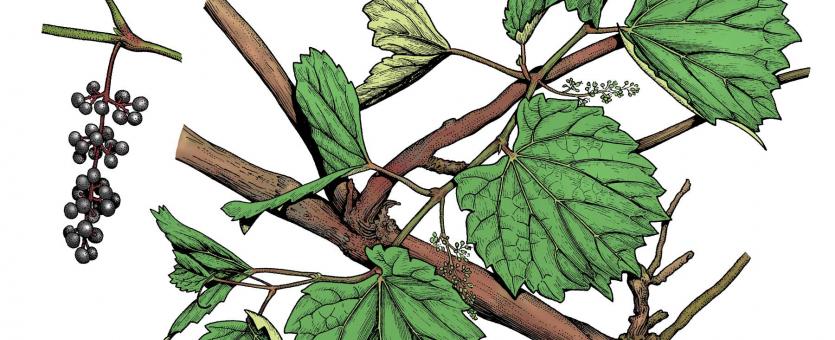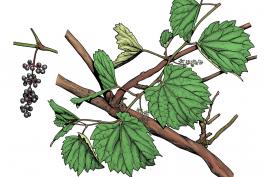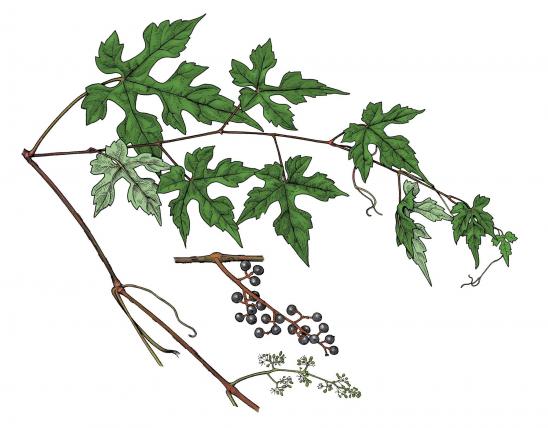
Sand grape is a bushy, sprawling, or trailing vine over rocky streambeds or along gravel bars; it rarely climbs, but it may reach a length of 8 feet; tendrils absent.
Leaves are alternate, simple, 3–4 inches (sometimes to 8 inches) wide, usually broader than long, sometimes shaped like a kidney bean, blade folded upward or trough-shaped to expose the pale green lower surface; basal sinus (the notch where the leaf stem meets the leaf) is very broad and sometimes flattened; margins with large teeth; upper surface light green, smooth; lower surface yellowish green, smooth. Leaf stalk deeply and broadly grooved, striped, green to dark crimson.
Stems, when young, are finely grooved, red, and very leafy at the ends due to the short distance between nodes. Tendrils are mostly absent; when they appear, they are opposite only the uppermost leaves or at tips of flowering or fruiting branches; thin, smooth, crimson. On older growth, the bark is dark cinnamon, growing darker with age, scaling off in broad plates after the second or third year.
Flowering is in May–June. Flowers are yellowish green, minute; male and female flowers in separate clusters on same plant; petals 5, dropping early. Clusters are ½–2 inches long; cluster stalk 1–2 inches long.
Fruit matures in July–August and drops early. Fruit round, black berries, ¼–½ inch broad, sweet, tender, thin-skinned. Berries are often somewhat doubled, as if two berries are grown together. Seeds 3 or 4 per fruit.
Similar species: Muscadine (Vitis rotundifolia) differs by having the bark of branches and main stem tight (not shredding as in sand grape); tendrils present and simple (not forked); pith is continuous through the nodes. Also, it is critically imperiled in our state; it occurs in low, wet woods and borders of swamps and bayous in southeastern Missouri.
Stems generally reach 8 feet in length.
Scattered in southern and central Missouri, mostly in the Ozark and Ozark Border divisions.
Habitat and Conservation
Occurs along banks of streams and rivers and bases of bluffs. Unlike other native Missouri grapes, which generally climb on other plants and grow far into the forest canopy, sand grape usually has a scrambling habit, forming low colonies on open gravel bars. Sand grape is often found only in the vegetative state (without flowers or fruits).
Status
This species has become extirpated from much of its range outside Missouri.
Human Connections
Sand grapes are sweet and comparatively large, considering the plant’s growth habit.
Because it is not such a powerful climber, and because of its low growth habit and attractive leaves and red stems, this species makes a good ornamental groundcover in rock gardens.
This species is quite important in the grape-growing industry as a source of hardy rootstocks for grafting.
This is one of the native grape species that was used extensively in rescuing European wine grape varieties in the late 1800s, after a New World root louse was accidentally imported to Europe. This aphidlike insect pest ravaged European vineyards, threatening to destroy the wine industry centered on Cabernet, Zinfandel, Riesling, Chardonnay, and many other famous varieties; fortunately, people figured out that New World grapes were naturally resistant to the pest, so Old World vines were grafted onto New World rootstocks.
Ecosystem Connections
The fruit is eaten by many species of birds and mammals, including wood duck, catbird, cardinal, bobwhite, ruffed grouse, wild turkey, raccoon, red fox, and deer.
The foliage is browsed b deer, and the tendrils are eaten by wild turkey.
The catbird, mockingbird, brown thrasher, and cardinal use the long strips of bark in the middle layer of their nests.
Several species of sphinx moths use grape-family species as larval food plants.





























